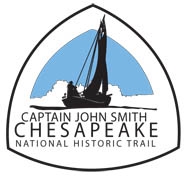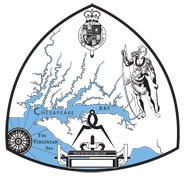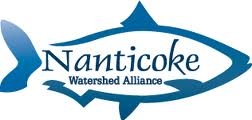

Come on a journey to remember and commemorate
the history and travels of Captain John
Smith!
Over four
hundred years ago, Englishman John Smith and a small crew set out
in an open boat to explore the Chesapeake Bay. Between 1607 and
1609 Smith mapped and documented nearly 3,000 miles of the Bay and
its rivers. Along the way he visited many thriving American Indians
communities and gathered information about this “fruitful and
delightsome land.” In December 2006 the U.S. Congress
designated the routes of Smith’s explorations of the
Chesapeake as a national historic trail—the first national
water trail.
Are you ready
to follow in the wake of Captain John Smith? Visit sites along the
National Historic Trail and learn about the native cultures and the
natural environment of the 17th-century Chesapeake through the
Captain John Smith Chesapeake Geotrail. The Trail provides
opportunities for you to experience the Bay through the routes and
places associated with Smith’s explorations. Caches will be
located in museums, refuges, parks, and towns in Virginia, Maryland
and Delaware along the rivers and creeks that Smith and his crew
explored four centuries
ago.
The Captain
John Smith (CJS) Geotrail launched June 4, 2011 with over 40 caches
within Maryland, Virginia and Delaware. A trackable geo coin will
be awarded to the first 400 geocachers, while supplies last, for
locating at least 15 CJS caches. To be eligible for the coin,
geocachers must download a passport from either the CJS Geotrail or Maryland Geocaching Society website.
Geocachers must find and log at least 15 finds, record the code
word from each cache on their passport and post a picture of
themselve at each cache location. After discovering the 15 required
caches, geocachers may have thier passports validated in person or
via mail at the National Park Service, Chesapeake Bay Office
located at 410 Severn Ave, Suite 314, Annapolis, MD 21403. Please
refer to the passport for complete validation instructions.
Participating in the CJS geotrail is fun and we
hope that many people join in. However, it is not a requirement for
logging your find on this cache once you find the container.

You are seeking a traditional hide, placed with permission of the
land owner. The cache is available 7 days a week from sunrise to
sunset. Please NO NIGHT CACHING! The cache is skillfully
hidden to blend in with the surroundings.
The Nanticoke River begins its journey in southern Delaware,
flowing southwest to the Chesapeake Bay through the Lower Eastern
Shore of Maryland. One of the Chesapeake’s healthiest rivers,
its 725,000-acre watershed provides excellent habitat of national
significance for many threatened plants and animals. The Nanticoke
is the most biologically diverse watershed on Delmarva. It is free
of dams and supports excellent fisheries. It has a rich history,
properties on the National Register of Historic Places, and the
northernmost stands of bald cypress on the Atlantic Coast. It also
has the highest concentration of bald eagles in the northeastern
United States.
The Nanticoke Watershed Alliance is a consortium of diverse
organizations representing industry, agriculture, environmental,
and community groups in Maryland and Delaware dedicated to working
together for the protection of the watershed. The Alliance is
working to bring Green Infrastructure to the Nanticoke watershed.
This is an inclusive process, with a focus on positive solutions
for community, human health, ecology, business, industry, and
working landscapes (our farming and forestry heritage). In order to
bring effective conservation to the entire watershed, the Alliance
is working to bridge the barriers of state and county lines to
produce a plan that encompasses the well-being of all the
watershed’s residents.
A signature event of the Alliance and partner organizations is the
Annual Shad Planking, celebrated to remember the once-flourishing
annual migratory return of the American Shad to the Nanticoke. The
Shad is an iconic symbol of the river and of the cultural heritage
of the Eastern Shore. Open-fire shad planking was a favorite method
of cooking shad, used by early settlers as well as Nanticoke Indian
communities. Shad populations have plummeted due to
over-harvesting, dam blockage, and poor water quality. Efforts by
the Nanticoke Watershed Alliance hope to help restore the habitat
for shad and result in higher population numbers.
Captain John Smith and 14 crew members explored the Nanticoke in
June, 1608. An initial encounter resulted in a decidedly unfriendly
greeting of arrows let loose from Nanticoke Indians on the
riverbanks. Smith wrote, “They were not sparing of their
arrows nor the greatest passion they could express of their
anger.” The next morning, the crew was beckoned to come
ashore by Indians holding baskets and dancing. Captain Smith feared
an ambush and did not disembark; instead, he ordered a volley of
shot to be fired. Later, he and his men spied smoke and rowed
ashore to explore 2 or 3 abandoned houses with fires smoldering
outside. This was Nause, the village, or fishing and hunting camp,
nearest the river’s mouth. By the end of the following day,
Captain Smith had been as far up the Nanticoke as present day
Delaware, traded with hundreds of Nanticoke, and learned valuable
information about a feared Indian nation called the
Massowomeck.

Thanks to HiTechMD for helping with this hide and to the
Maryland Geocaching Society for assisting with this
project!